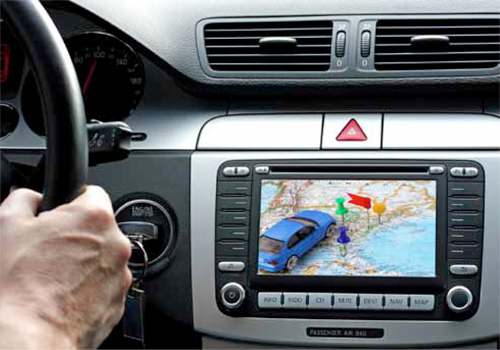
1. Visteon e-Bee
Intelligent mobility. Visteon’s e-Bee concept car gathers and disseminates useful driving-related data, acts as part of a wider mobility-enabling network, and integrates technology and design that is connected, simple and flexible.
Camera-enhanced cockpit concept. It assists the driver by providing automatic personalisation, pedestrian sensing, traffic sign recognition and even intruder alerts.
Human Artificial Bayesian Intelligence Technology (HABIT). It uses artificial intelligence to learn the driver’s habits and creates a truly personalised experience based on this information. It also features cloud-centred profile storage.
Pressure-activated smart panel. This smart panel detects the presence of the user’s finger but does not activate until a small amount of pressure is applied. This ‘touch with intent’ capability is enhanced with visual and audible feedback, and will be expanded on future implementations.
Head-up display solution. Developed in partnership with BAE Systems, it delivers industry-leading display image quality in a compact and efficient optical design.
Global digital radio solution. It provides software-reconfigurable mobile reception across multiple digital radio standards.
2. Cadillac User Experience
Contextual design. The Cadillac User Experience (CUE) has been designed ground up, based on an understanding of consumer usage and wishes. The designers classified users into eight distinct personas to understand their needs and develop features. Then, they built an extensive design and engineering specification manual that included more than 1500 pages of storyboards, functions and program wire-frames. They also created HMI state charts that described the interactive behaviour of the system to be programmed.
Responsive touch-screen. A 20.3cm (8-inch) capacitive touch screen allows swipe and pinching gestures to move and resize items on the main screen.
Haptic feedback. The panel gives users a pulsating sensation when they select menu items.
Proximity sensing. This technology detects the presence of users and minimises the display when not in use, thereby conserving power.
Built-in 3D navigation. It includes turn-by-turn natural speech recognition and auto-fill location input. It also provides map-integrated weather reports.
Open platform. The Linux-based CUE platform is open to developers, so they can develop new applications for Cadillac.
3. Mercedes-Benz
Cross-traffic assist. Mercedes-Benz‘ BAS Plus technology reduces rear-end collisions and sccidents at road crossings. If the system detects a hozardours situation, the driver is prompted to apply the brakes immediately. If braking is too slow, the brake pressure is automatically increased to avoid collision.
360-degree camera. A 360-degree camera assists the driver in parking, enabling all-round visibility with all four sides of the vehicle in veiw. It provides a top-down view of the car and its immediate suroundings.
Steering assistance. The distronic Plus proximity control system with steering assist feature ensures a desired distance from other vehicles. It monitors both the longitudinal and lateral monements of your car at speeds of up to 200 kmph, and guarantees direction stability with lateral lane guidance.
BlueEFFICIENCY. This feature reduces fual consumption by up to 12.1 per cent while maintaining the same level of performance.
ECO display. ECO display in the instrument cluster analyses individual driving styles and provides specific tips on how to reduce fuel consumption. Three bar-type chart displays provide feedback on the economic efficiency of the driving style and point the way to potential savings.
4. BMW
iDrive. This intuitive panel in BMW cars helps control entertainment, information, communication and navigation functions. It comprises a control display and a controller, and features a high-resolution glare-free screen, attractive visuals, animations, simple menus, biometric features and voice control.
Multi-function steering wheel. Keys are ergonomically integrated in the steering wheel and programmed to activate often-used features including HVAC (heating , ventilation and air-conditioning) control and cruise control. In some models, two additional keys are left free so that these can be programmed for any function as per the user’s needs.
Integrated navigation system. It combines navigation, office and multimedia functions. Sensors monitor wheels and the steering angle and canlocalise the vehicle at all times. The system is reliable and can navigate even when the GPS signal is weak. The functions complement each other; for instance, the volume is automatically lowered before a navigation announcement is made. The system features a high-resolution display; virtual, photo-realistic 3D views; fast 1.3GHz processor with built-in graphoics chip; control display for computer functions; and a 20GB hard drive for multimedia data.
5. Ford
Hands-free lift-gate. Using motion-sensing technology, Ford Escape allows quick and easy access to the cargo area without keys.
Extensive Driver assistance. With more than 145 actuators, 4716 signals and 74 sensors including rader, sonar, cameras, accelerometers, temperature and even rain sensors, the 2013 Fusion car can monitor the perimeter around it and see into places that are not readily visible from the driver’s seat. Sensors produce more than 25 GB of data per hour, which is analysed by more than 70 on-board computers. Actuators combined with signal information from driver-assist sensors can alart the driver to potential dangers, actively assisting in parking and lane keeping.






